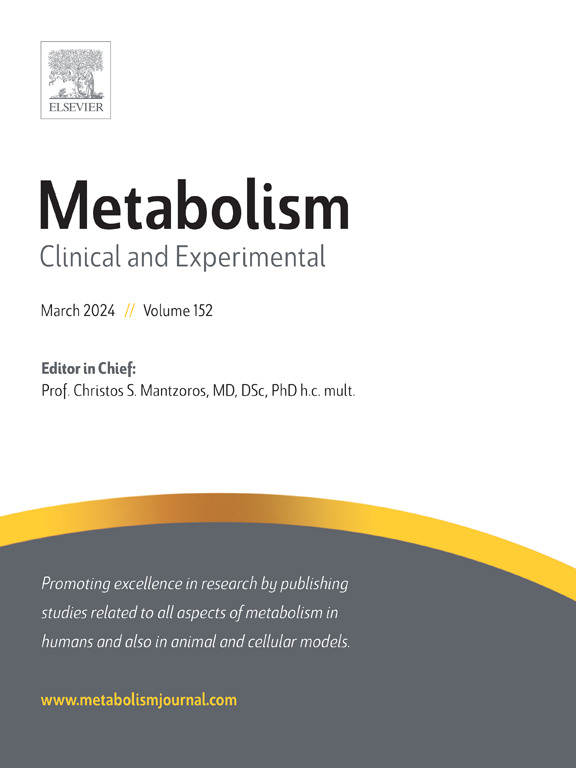Central NUCB2/nesfatin-1 signaling ameliorates liver steatosis through suppression of endoplasmic reticulum stress in the hypothalamus
IF 10.8
1区 医学
Q1 ENDOCRINOLOGY & METABOLISM
引用次数: 0
Abstract
Background & aims
Nucleobindin-2 (NUCB2)/nesfatin-1, a signal with recognized anorexigenic and insulin-sensitizing properties in peripheral tissues, is expressed within the hypothalamus. However, the potential involvement of central nesfatin-1 signaling in the pathophysiology of hepatic steatosis remains unknown. This study aimed to determine whether and how central NUCB2/nesfatin-1 plays a role in liver steatosis.
Methods
We generated Nucb2 knockout (Nucb2−/−) rats and administered continuous intracerebroventricular (ICV) nesfatin-1 infusion, while observing its effect on liver steatosis. The molecular mechanism of action of nesfatin-1 was elucidated via proteomics, phosphoproteomics and molecular biology methods.
Results
Herein, we present compelling evidence indicating diminished NUCB2 expression in the hypothalamus of obese rodents. We demonstrated that chronic ICV infusion of nesfatin-1 mitigated both diet-induced obesity and liver steatosis in high-fat diet (HFD)-fed Nucb2−/− rats by regulating hypothalamic endoplasmic reticulum (ER) stress and Akt phosphorylation. Furthermore, we revealed that the increase in hypothalamic insulin resistance (IR) and ER stress induced by tunicamycin infusion or Ero1α overexpression exacerbated hepatic steatosis and offset the favorable influence of central nesfatin-1 on hepatic steatosis. The metabolic action of central nesfatin-1 is contingent upon vagal nerve transmission to the liver. Mechanistically, nesfatin-1 impedes ER stress and interacts with Ero1α to repress its Ser106 phosphorylation. This leads to the enhancement of Akt activity in the hypothalamus, culminating in the inhibition of hepatic lipogenesis.
Conclusions
These findings underscore the importance of hypothalamic NUCB2/nesfatin-1 as a key mediator in the top-down neural mechanism that combats diet-induced liver steatosis.

中枢 NUCB2/nesfatin-1 信号通过抑制下丘脑内质网应激改善肝脏脂肪变性。
背景和目的:核吲哚-2(NUCB2)/nesfatin-1是一种在外周组织中具有公认厌食和胰岛素敏感特性的信号,在下丘脑中也有表达。然而,中枢内司蛋白-1 信号在肝脏脂肪变性的病理生理学中的潜在参与仍然未知。本研究旨在确定中枢 NUCB2/nesfatin-1 是否以及如何在肝脏脂肪变性中发挥作用:方法:我们培育了Nucb2基因敲除(Nucb2-/-)大鼠,并连续脑室内注射(ICV)nesfatin-1,同时观察其对肝脏脂肪变性的影响。通过蛋白质组学、磷酸化蛋白质组学和分子生物学方法阐明了内司法亭-1的分子作用机制:在此,我们提出了令人信服的证据,表明肥胖啮齿动物下丘脑中的 NUCB2 表达减少。我们证明,通过调节下丘脑内质网(ER)应激和Akt磷酸化,长期ICV输注nesfatin-1可减轻高脂饮食(HFD)喂养的Nucb2-/-大鼠饮食诱发的肥胖和肝脏脂肪变性。此外,我们还发现,输注曲安奈德霉素或Ero1α过表达诱导的下丘脑胰岛素抵抗(IR)和ER应激的增加加剧了肝脂肪变性,并抵消了中枢nesfatin-1对肝脂肪变性的有利影响。中枢nesfatin-1的代谢作用取决于迷走神经对肝脏的传导。从机理上讲,nesfatin-1 会阻碍 ER 应激,并与 Ero1α 相互作用,抑制其 Ser106 磷酸化。这导致下丘脑中Akt活性增强,最终抑制了肝脏脂肪生成:这些发现强调了下丘脑NUCB2/nesfatin-1作为自上而下的神经机制中的一个关键介质的重要性,该机制可对抗饮食诱导的肝脏脂肪变性。
本文章由计算机程序翻译,如有差异,请以英文原文为准。
求助全文
约1分钟内获得全文
求助全文
来源期刊

Metabolism: clinical and experimental
医学-内分泌学与代谢
CiteScore
18.90
自引率
3.10%
发文量
310
审稿时长
16 days
期刊介绍:
Metabolism upholds research excellence by disseminating high-quality original research, reviews, editorials, and commentaries covering all facets of human metabolism.
Consideration for publication in Metabolism extends to studies in humans, animal, and cellular models, with a particular emphasis on work demonstrating strong translational potential.
The journal addresses a range of topics, including:
- Energy Expenditure and Obesity
- Metabolic Syndrome, Prediabetes, and Diabetes
- Nutrition, Exercise, and the Environment
- Genetics and Genomics, Proteomics, and Metabolomics
- Carbohydrate, Lipid, and Protein Metabolism
- Endocrinology and Hypertension
- Mineral and Bone Metabolism
- Cardiovascular Diseases and Malignancies
- Inflammation in metabolism and immunometabolism
 求助内容:
求助内容: 应助结果提醒方式:
应助结果提醒方式:


